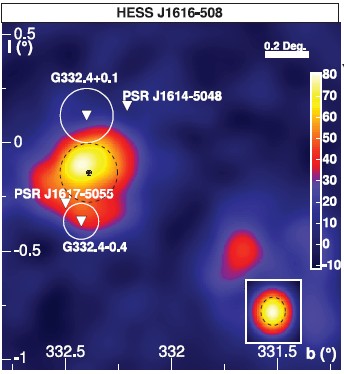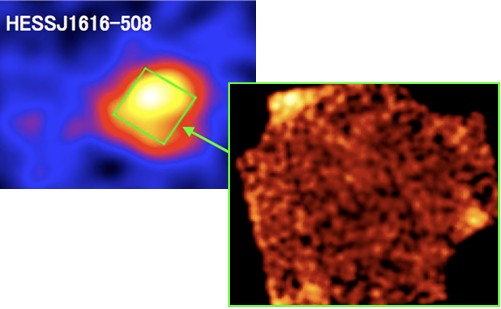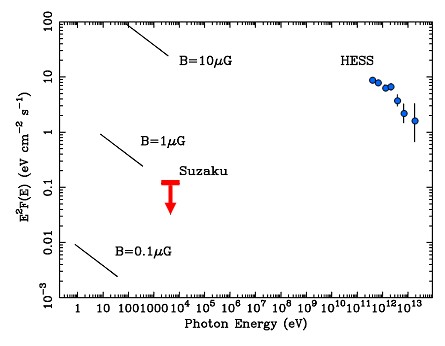HESS J1616-508 - Evidence for a Dark Particle Accelerator
January 2007

HESS J1616-508 (Fig. 1) is one of the objects discovered in the H.E.S.S. survey of the Galactic Plane; it is an extended source with a size of about 8 arc min., a flux of about 20% of the Crab Nebula, and a gamma-ray spectral index of 2.35. While bracketed by two supernova remnants, G332.4+0.1 (also known as MSH 16-51, Kes 32; MOST radio image) and G332.4-0.4 (RCW 103, see also here; MOST radio image), neither of those provides a likely counterpart. More interesting is the young pulsar PSR J1617-5055 (Torii et al. 1998) which was proposed as a gamma-ray source (Hirotani 2001) and which provides sufficient energy; about 1% of the spin-down power of the pulsar would be needed to feed the high-energy gamma rays. However, the pulsar is offset by almost 0.3 degr. from the H.E.S.S. source. At the time of the discovery of the gamma ray source, such large offsets were considered implausible. In the meantime, several examples of TeV sources were discovered by H.E.S.S. where the gamma-ray emission region is located asymmetrically with respect to the pulsar; the two most clear-cut cases are Vela-X and HESS J1825-137 (see also Aharonian et al., 2006). Hence, such a scenario appears more plausible. Among the alternative explanations proposed for such "Dark Accelerators", i.e. sources without X-ray or radio counterpart, are old supernova remnants where electron acceleration cannot compete with radiation cooling and where gamma rays are produced in proton interactions (Yamazaki et al. 2006), or gamma-ray burst remnants, where again high magnetic fields in the early phases of the expansion kill all high-energy electrons due to radiative losses (Atoyan et al. 2006).
Sensitive X-ray observations are therefore crucial to determine the nature of TeV sources such as HESS J1616-508, and in a sense the Suzaku satellite is ideal to hunt for counterparts of the extended H.E.S.S. sources: Suzaku's instruments provide a - by X-ray standards - modest angular resolution but have very low instrumental backgrounds, allowing for the sensitive detection even of faint extended sources. Suzaku observations of HESS J1616-508 were reported by Matsumoto et al. (2006). In an exposure centered on the H.E.S.S. source and covering a large fraction of it, no significant X-ray emission was detected (Fig. 2), and upper limits are given (Fig. 3). For many typical gamma-ray sources, the ratio of gamma-ray energy flux (in the 1-10 TeV range) to X-ray energy flux (2-10 keV) is of order unity; for HESS J1616-508, the upper limit on the X-ray flux implies that at least 55 times more energy goes into gamma rays (Matsumoto et al., 2006). For an electron accelerator and typical Galactic magnetic fields of about 5 microGauss, one would expect a ratio around unity, so an electronic origin of the gamma-rays seems ruled out. A few caveats, however, should be mentioned: for microGauss fields, X-rays at energies of some keV originate from ~100 TeV electrons whereas the H.E.S.S. gamma-rays are produced by lower-energy electrons in the 10 TeV range. This is also evident from Fig. 3, where the X-ray flux predicted under the assumption of an electronic origin is shown: at least for small B fields, the H.E.S.S. gamma rays correspond to sub-keV X-rays. If the electron energy spectrum has a sharp cutoff between 10 and 100 TeV, the two data sets could therefore be reconciled. Also, gamma ray production could be boosted relative to X-rays by providing intense target photon fields for Inverse-Compton scattering of electrons, see e.g. Hinton and Aharonian (2006); however, unlike near the Galactic center there is no obvious reason for such an enhancement in HESS J1616-508.
References:
The H.E.S.S.
survey of the Inner Galaxy in very high-energy gamma-rays, H.E.S.S.
collaboration, F. Aharonian et al.,
Astrophysical Journal 636 (2006) 777-797
(note that the paper
contains a typing mistake concerning the size of the source which is quoted as
16' in the text; the value of 0.136 degr. given in Table 3 is correct)


